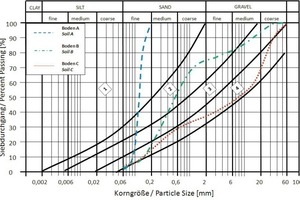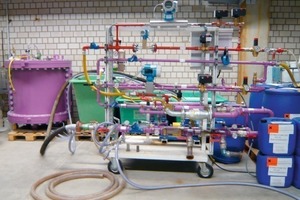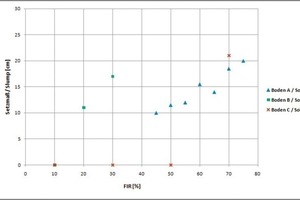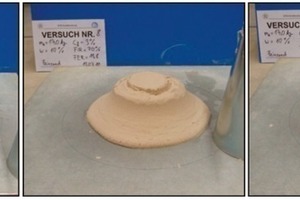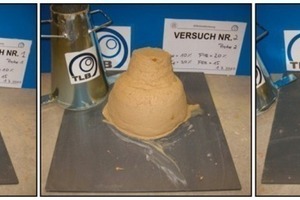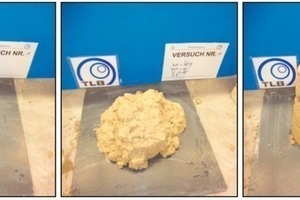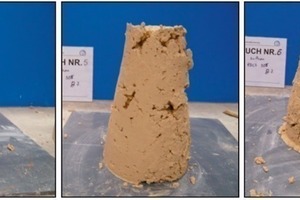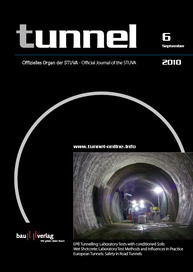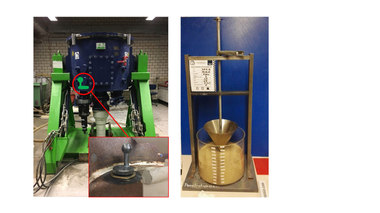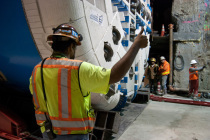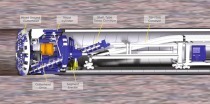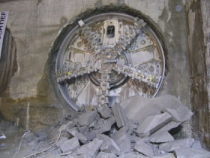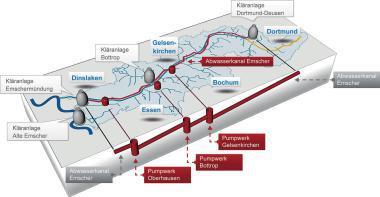Laboratory Tests with various conditioned Soils for Tunnelling with Earth Pressure Balance Shield Machines
The main application area for earth pressure balance (EPB) shield machines is soil with at least 30 % of fines. Especially in coarse-grained material and in connection with ground-water pressure, the EPB shield needs the application of conditioning, mostly with foam. To improve the theoretical basis regarding the foam itself, research with realistically produced foam has been carried out at the Institute for Tunnelling and Construction Management. The article is a presentation held in October 2010 in London/GB at the
4th BASF TBM Conference.
The main application area for earth pressure balance (EPB) shield machines is soil with at least 30 % of fines. Especially in coarse-grained material and in connection with ground-water pressure, the EPB shield needs the application of conditioning, mostly with foam. To improve the theoretical basis regarding the foam itself, research with realistically produced foam has been carried out at the Institute for Tunnelling and Construction Management. Properties of different soil-foam-mixtures consisting of coarse-grained material were specified and analysed regarding the workability with various injection ratios under atmospheric conditions. The test results show a quantitative relation between the workability and the suitability for the application of EPB shields.
1 Application of EPB Shield Machines in Coarse Ground
Through recent developments, the range of application for EPB shields can be extended into more coarse-grained soils with less cohesive soil, under the application of soil conditioning. In EPB tunnelling, the excavated material is used for active face support. The support medium has to fulfill a range of required characteristics, for instance workability, water permeability, stickiness and abrasivity. As project experience shows, e. g. Milan (1994), Lyon (1996), Barcelona (2003) or Turin (2004), the operation of EPB shields is increasingly executed in coarse-grained grounds, originally known as standard application range for slurry shield machines. In order to ensure an economical application in coarse-grained soils, ground treatments may be necessary. Depending on the soil properties, the key aims of soil conditioning can be stated as follows [7]:
■ In coarse-grained soils, temporary changes of the muck properties might be necessary to ensure an adequate flow of the soil, both in the excavation chamber and in the screw conveyor.
■ In porous soils below the ground-water table, a reduction of the permeability is required to ensure an effective face support maintaining the natural pore pressure at the tunnel face to prevent seepage flow as well as resulting seepage forces and erosion processes.
■ An increase of the support medium compressibility dampens pressure fluctuations caused by muck volume variations resulting from the actual combination of the cutting wheel rotational speed and the excavation speed of the screw conveyor.
■ A reduction of the inner friction of the soil decreases the torque of the cutting wheel and the screw conveyor. Thereby, the wear of tools and steel structures in the excavation chamber is reduced, too.
Beyond that, fractured sedimentary rock can be suitable for the application of an EPB shield, too, most likely by conditioning. Because both types of ground material, coarse-grained soils and fractured rock, cannot fulfill all the requirements, new methods are necessary to refine the specifications on the support medium in dependence of the ground conditions and further advance parameters.
2 State of the Art
Testing of conditioned soils has been performed by various researchers, see [1, 5, 6, 11]. Conditioning agents were produced by laboratory foam generators, partially under atmospheric pressure conditions. The foam was mixed with selected soils and in some cases injected into pressure tanks. The conditioned material was extracted with a screw conveyor under pressure in order to perform tests on the soil-foam-mixtures under atmospheric conditions, afterwards.
A soil-foam-mixture is described with various parameters, which have to comply with requirements regarding the use as support medium. Tests can be conducted to determine the properties of a soil-foam-mixture like the
■ density
■ shear strength
■ compression behavior
■ water permeability
■ stability
■ rheological properties
■ drainage ability
■ workability.
Thereof, the workability is an indicator for the plasticity of the support medium, comparable to the consistency of cohesive soils and thus a criterion for the applicability of EPB tunnelling. The workability can be estimated with the slump test, known from testing of fresh concrete [3]. Former research on the workability [10] led to suitable values for the slump differing in a range from approx. 10 cm to 20 cm.
Based on literature [5] and project experiences, Thewes [9] developed a diagram with application ranges for EPB shield machines depending on ground conditions and extra treatments (Fig. 1). He defines four areas:
1 Addition of water for consistency and foam for stickiness maybe necessary
2 Foam as conditioning agent has possibly to be added
3 Ground suitable when water pressure does not exceed 2 bar; foam and polymers for soil conditioning
4 Preferably no water pressure at all; foam, polymers and filler (fines) for soil conditioning.
Beneath line 4, the ground is most likely not suitable for EPB tunnelling. However, it must be clear that these areas are general indications instead of sharp definitions.
To achieve the mentioned goals of soil conditioning, the ground in the excavation chamber is treated mostly with foam but it can also be supplemented by other additives, e. g. polymers or high-density slurries. Therefore, the additives can be added through injection points into the excavation chamber, in front of the cutting wheel and into the screw conveyor. The ratio of the volume flows of the injected foam and the excavated ground material is described as foam injection ratio (FIR). Typical injection ratios roughly correlate with void ratios of the soil. Formulas for calculations of the flow of various ingredients of foam were recently published in [8]. The dependencies between the parameter values and the actual adjustments for the foam generator can be estimated with the nomogram according to Budach [2]. Typical values for the concentration cf range from 1.5 % to 5.0 %, whereas the range for the FER varies between 10 and 25.
3 Experimental Concept
While Fig. 1 qualitatively shows the grain-size distribution range for the operation of EPB shield machines and the necessity for applying conditioning agents, a prediction of the ground behavior regarding the workability of the support medium and the estimation of quantitative parameters for soil conditioning is the goal of ongoing research. Any ground composition results in particular demands in order to achieve adequate conditions. Therefore, laboratory tests are performed at the Institute for Tunnelling and Construction Management at the Ruhr-University Bochum.
Three different soil samples are being investigated regarding the effective applicability for an EPB shield (Fig. 2). Curve A (blue) represents a pure fine sand, whereas curve B (green) and curve C (red) are grain-size distributions of actual tunnel projects. Curve B results from a mixed tunnel face of two different soil layers and consists of a fraction of gravel of approx. 25 %. Curve C consists of about 60 % of gravel and originates from fractured sedimentary rock material. Both project grain-size distributions show a high fraction of coarse-grained soil, i. e. the ground conditions comply roughly with the application areas 3 and 4 according to Fig. 1. All three samples consist of a low fraction of fines.
To generate foam for conditioning, a foam generator is used, capable of producing foam under realistic boundary conditions such as volume flow and ambient pressure. Two different foam guns are available, both identical to those used in practice (industrial foam guns). The following parameters can be altered with the foam generator shown in Fig. 3:
■ type of foam gun (2 foam guns as used as in practice and 1 laboratory foam gun)
■ volumetric flow rate of foam QF (150 l/min to 650 l/min or 40 l/min to 100 l/min resp.)
■ conveying pressure
■ length of transport system (with up to 30 m of additional pipe lining)
■ conditioning agent
■ concentration of surfactant solution
■ foam expansion ratio FER.
The soil-foam-mixture is created by filling soil into a laboratory mixer and moistened to a required water content. The produced foam is added in defined amounts to the soil depending on the FIR. The ingredients are mixed together within 30 seconds.
To evaluate the workability of the generated support medium, a slump test is performed according to DIN EN 12350-2/-8 [3, 4] for fresh concrete and self-compacting concrete: The soil-foam-mixture is inserted in three layers into a cone with specific geometry (h = 30 cm, dmax = 20 cm). After inserting a layer the material has to be compacted. Finally, the cone is lifted. The resulting slump [3] and the slump flow [4] reference as guide values for the workability. Results from former slump tests are described by Vinai [10], showing that a slump value between approximately 10 cm and 20 cm can offer a good workability for tunnelling with EPB shields. This range is going to be considered as aim of the slump tests in order to evaluate the workability.
4 Laboratory Tests and Results
In one series of laboratory tests performed in Bochum, the following foam parameters stayed constant for the whole experimental programme: cf = 3.0 %, FER = 15, QF = 70 l/min. After the foam production, it was added immediately in various amounts to the moistened soils A, B and C to generate different soil-foam-mixtures for the testing, depending on the FIR.
From the soil-foam-mixtures samples were taken and slump tests were performed according to the precedent description. The results of the laboratory investigations for the grounds A, B and C are shown in Fig. 4.
The slump test results of soil A show an increase of the slump with increasing values for the FIR. The slump is 10 cm for FIR = 45 % and 20 cm for FIR = 75 %. Regarding to the suitability for EPB tunnelling, the estimation shows that the applicability is given when conditioning is applied, for example as illustrated with foam. Adequate values for the FIR range from 45 % to 75 %. Selected pictures of the results are displayed in Fig. 5.
Although soil B consists of a higher fraction of coarse-grained material, a suitable workability for effective tunnelling operations with earth pressure balance shield machines can be achieved by conditioning with less foam in comparison to soil A. This might result from the broader grain-size distribution of ground B leading to a smaller void volume. A FIR = 20 % leads to a slump of 11 cm (Fig. 6.2), whereas a FIR = 30 % increases the slump to 17 cm (Fig. 6.3). Thus, tunnelling in this ground seems to be suitable by conditioning the soil with foam (FIR = 20 % to approx. 30 %).
Conditioning ground C did not lead to meaningful results concerning the slump as indicator for the workability. Injecting foam, the FIR amounting 10 % to 50 %, did not result a slump (Fig. 7.1). When injecting 70 % and lifting the cone, the sample collapsed immediately to an inhomogeneous pile of liquid and ground material (Fig. 7.2). The addition of 0.2 % of polymers to the same sample (i. e. PIR = 0.2 %) influenced the material to the effect that the stability seemed to be restored to its former condition and again a slump did not result. Hence, the outcomes cannot be seen comparatively with respect to soils A and B with the results not indexing a significant valuation of the workability.
To analyse the workability behavior of ground C conditioned not with foam but high-density limestone slurry (HDLS) further tests were performed. Pictures of the results are shown in Fig. 8. Adding HDLS in different amounts did not influence the slump behavior of the sample, though the inclusion of air could be reduced. The sample in Fig. 8.2 consists of 30 % of HDSL which still leads to a slump of 0 cm. Adjoining foam to the soil-slurry-mixture (HDSL = 30 %, FIR = 30 %) resulted a slump of 3 cm.
5 Conclusion and Outlook
Altogether, the results of the laboratory tests indicate that the definition of the operation ranges for effective EPB tunnelling (Fig. 1) is a good orientation for the application of conditioning agents. Though, precise values for the regulation of ground conditioning have to be determined in tests before the operation, because they cannot be derived from the grain-size distribution curves of the ground. Different conditioned soils could partially achieve the same quantifications concerning the workability (i. e. slump results) just by varying the FIR, maintaining stable foam parameters otherwise.
Particle compositions following from fractured rock can reflect granulometric distributions like resulting from soil. As the test concerning conditioning of soil C with HDLS showed a transformation of the sample properties, foam should not be the only conditioning agent to consider but polymers and high-density slurries or even a combination of all three conditioning media should be taken into account, too. In future research, it should be focused on conditioning of comparative material (for example from mixed face conditions) as well.

![1 Application range for EPB shield machines depending on necessary soil treatments after [5] and extended by [9]](https://www.tunnel-online.info/imgs/tok_64b7e953fc9c2ddd0e5a0bfeedf1d54e/w300_h200_x400_y256_100836440_4e15999aa6.jpg)
